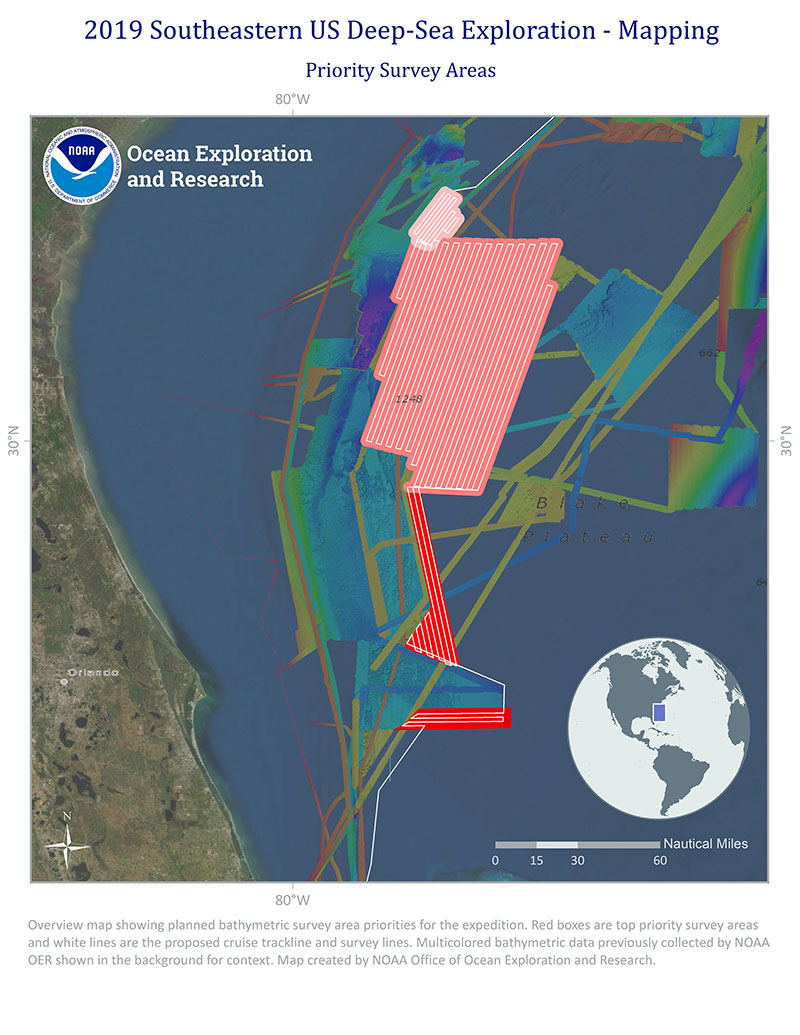
By Derek Sowers, Expedition Coordinator, Physical Scientist - NOAA Office of Ocean Exploration and Research
October 5 - 26, 2019

Figure 1. Map showing the planned operations area for the mapping leg of the 2019 Southeastern U.S. Deep-sea Exploration. The white line indicates the approximate trackline the ship will follow on transits, and the red shaded boxes represent high-priority areas to complete exploratory ocean mapping work. Image courtesy of the NOAA Office of Ocean Exploration and Research. Download map (jpg, 7.7 MB).
From October 5 - 26, 2019 the NOAA Office of Ocean Exploration and Research (OER) and NOAA Ship Okeanos Explorer will conduct a telepresence-enabled ocean exploration mapping cruise from North Kingstown, Rhode Island, to Miami, Florida. This is the first part of the two-cruise “2019 Southeastern U.S. Deep-sea Exploration” expedition. The first cruise will involve 24-hour-per-day ocean mapping operations, while the second cruise will include remotely operated vehicle (ROV) and mapping operations.
The first four days of the mapping portion of the expedition will entail transiting from Rhode Island to the primary surveying area, with the rest of the time spent conducting systematic ocean mapping operations in U.S. federal waters offshore from Georgia and Florida, in a region called the Blake Plateau. Although this region is within 100 miles of heavily populated regions of the U.S. East Coast, large areas of the seafloor here have not yet been mapped with high-resolution sonars. The mapping work conducted during this leg will result in high-resolution maps of the seafloor and provide acoustic backscatter data information about the seabed and water column. New mapping data in this region are transforming scientific understanding of the marine habitats found here, including recent discoveries of some of the nation’s most extensive contiguous formations of deep-sea coral reefs.
NOAA identified the mapping focus areas planned for this cruise as top priorities in coordination with numerous marine scientists and managers, including key resource management agency partners from the United States Geological Survey, the Bureau of Ocean Energy Management, and the South Atlantic Fisheries Management Council . The information collected during the expedition will also contribute directly to the ecosystem assessment work being coordinated as part of the five-year interdisciplinary DEEP SEARCH study.

Figure 2. Map showing the priority ocean exploration mapping areas for the 2019 Southeastern U.S. Deep-Sea Exploration - Mapping mission. The red polygons indicate priority mapping areas, and the white lines show the proposed cruise track the ship will follow in order to map these areas. Multibeam bathymetry data previously collected by NOAA OER are shown in the background for context. Image courtesy of the NOAA Office of Ocean Exploration and Research. Download map (jpg, 4.5 MB).
Building on previous work in the region by NOAA OER and other partners, this exploratory mapping expedition will focus operations on areas generally deeper than 200 meters (656 feet) in the U.S. Exclusive Economic Zone. Data collected on this leg of the expedition will be used immediately to plan more detailed exploration of newly discovered features using ROVs Deep Discoverer and Seirios on the ROV/mapping cruise of the 2019 Southeastern U.S. Deep-sea Exploration expedition.
This expedition is part of the Atlantic Seafloor Partnership for Integrated Research and Exploration (ASPIRE) campaign, a major multiyear, multinational collaborative field program focused on increasing our collective knowledge of the North Atlantic Ocean in support of the Galway Statement on Atlantic Ocean Cooperation , an initiative between the United States, Canada, and the European Union to advance knowledge of the Atlantic for improved ocean stewardship and understanding.
Engaging and training the next generation of ocean explorers is an important mission goal of NOAA OER. Onboard this cruise will be three young scientists participating in OER’s Explorer-in-Training Program. This program is open to enrolled undergraduate and graduate marine science students as well as those who have recently graduated from a higher education program. Joining the mission team on an OER expedition is a unique and highly competitive early-career opportunity, and the three individuals selected for this cruise will obtain exceptional hands-on experience in ocean exploration, at-sea research operations, and ocean mapping technology.
During the cruise, OER will share expedition news on social media and its Ocean Explorer website. Exploratory missions like this are necessary to expand our knowledge of unknown and poorly known deepwater areas and to provide data for decision makers. All data collected on this expedition will be available in NOAA’s public data archives within 60-90 days of the conclusion of the cruise and accessible via the NOAA Ocean Exploration Data Atlas.